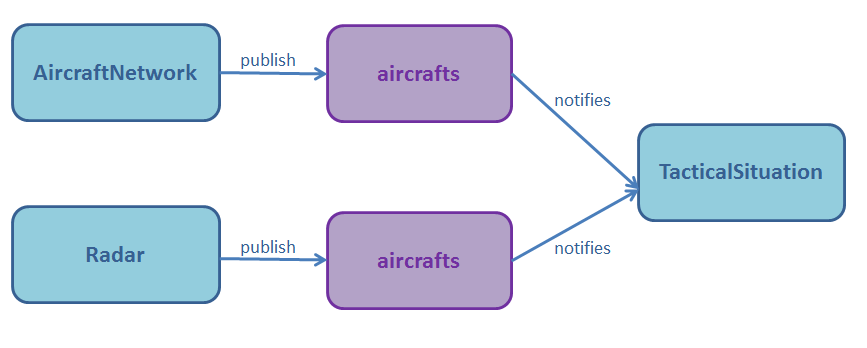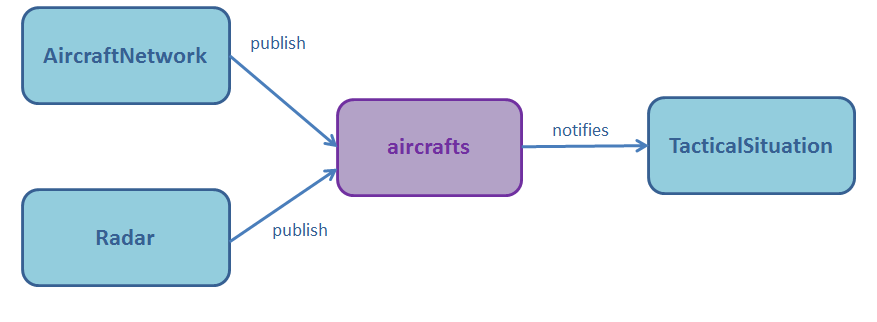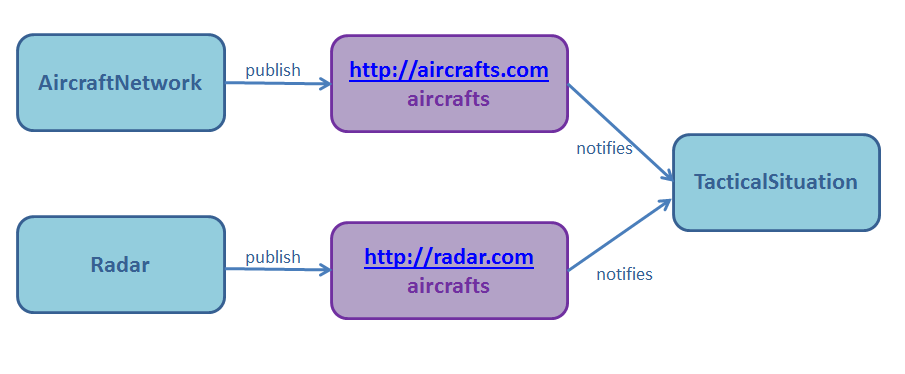Home
Categories
Dictionary
Glossary
Download
Project Details
Changes Log
What Links Here
FAQ
License
Namespace
1 Name conflicts and namespace solution
1.1 The problem
1.2 The solution
2 Usage in Java modules
2.1 Etting a service instance in a module
3 Example
3.1 Services declaration
3.2 Types declaration
3.3 Interfaces declaration
4 Notes
5 See also
1.1 The problem
1.2 The solution
2 Usage in Java modules
2.1 Etting a service instance in a module
3 Example
3.1 Services declaration
3.2 Types declaration
3.3 Interfaces declaration
4 Notes
5 See also
Namespaces is a concept which allow to tie Services and types to a particular URI[1]


However this may not work because even if it is possible to emit the same service by two modules:

Namespaces can be defined for services declarations and types declarations, and referenced in the modules services interface.
Note that services of a specified namespace can access types of the same namespace, or types with no namespace declaration.
The elements which have a namespace and which are used in Java modules are:
For example:
URI is the Uniform Resource Identifier concept, which allows to define unambiguously a resource
, and avoid name conflicts.
Name conflicts and namespace solution
When you use many modules, you can end having a lot of services, which makes quickly difficult to avoid name conflicts.The problem
For example, let's looks at this example where there are two services of the same name:
- The
AircraftNetworkmodule publish theaircraftsservice, which contain a list of aircrafts from the network. For example, it could be the aircrafts seen by the AWACS - The
Radarmodule publish anotheraircraftsservice, which contain a list of aircrafts seen by the Radar
aircrafts. We could for example consider the following architecture:
However this may not work because even if it is possible to emit the same service by two modules:
- It is not possible by default for publish Services to have more than one provider for the same service[2]
However this behavior can be overriden, see Accepting multiple providers
- The two
aircraftsservice represent different data, and may even not contain the same data content
The solution
To fix this problem, the solution is to add a namespace URI to the twoaircrafts services, so they will still keep their name, but they will live in two different namespaces:
Namespaces can be defined for services declarations and types declarations, and referenced in the modules services interface.
Note that services of a specified namespace can access types of the same namespace, or types with no namespace declaration.
Usage in Java modules
Main Article: Java modules
The elements which have a namespace and which are used in Java modules are:
- The services through the ServiceInstance class
- The types through the Type class
- The NamespaceElement.getKey() method return the NamespaceKey of the element
<services> <namespace uri="http://aircrafts.com" > <subscribe name="aircrafts" > <data name="aircrafts" type="aircraftsArray" /> </subscribe> </namespace> </services>The
http://aircrafts.com:aircrafts service key can be checked with:public class myModule { private NamespaceKey AIRCRAFTS = NamespaceKey.createKey("http://aircrafts.com", "aircrafts"); public void subscribe(ServiceInstance service) { NamespaceKey key = service.getKey(); if (key.equals(AIRCRAFTS)) { .. do something with the aircrafts } } }
Etting a service instance in a module
The Module.getService(String, String) and Module.getService(NamespaceKey) methods allow to get the service instance with a specified name and URI.For example:
public class myModule { private ServiceInstance acService = null; public void init(Module module) { NamespaceKey aircraftsKey = NamespaceKey.createKey("http://aircrafts.com", "aircrafts"); acService = module.getService(aircraftsKey); // could also be module.getService(http://aircrafts.com", "aircrafts") } public void start() { ... // populate the aircrafts service acService.invoke(); } }
Example
In our example, we have twoaircrafts service:- The first one contain a list of aircrafts from the network. We will use the "http://aircrafts.com" URI to specify its namepace
- The second one contain a list of aircrafts seen by the Radar. We will use the "http://radar.com" URI to specify its namepace
Services declaration
We will have the following services declaration:<services> <namespace uri="http://aircrafts.com" > <publish name="aircrafts" > <data name="aircrafts" type="aircraftsArray" /> </publish> </namespace> <namespace uri="http://radar.com" > <publish name="aircrafts" > <data name="aircrafts" type="aircraftsArray" /> </publish> </namespace> </services>
Types declaration
In our case, we have also the sameaircraftsArray type names, so we should also declare our two types in separate namespaces:<services> <namespace uri="http://aircrafts.com" > <structType name="aircraft" > ... </structType> <arrayType name="aircraftsArray" type="aircraft" /> </namespace> <namespace uri="http://radar.com" > <structType name="aircraft" > ... </structType> <arrayType name="aircraftsArray" type="aircraft" /> </namespace> </services>
Interfaces declaration
We should refer to the proper services using their associated namespaces:<module name="AircraftSystem" > <interfaces> <subscribe service="aircrafts" uri="http://aircrafts.com" /> <subscribe service="aircrafts" uri="http://radar.com" /> </interfaces> </module>
Notes
- ^ URI is the Uniform Resource Identifier concept, which allows to define unambiguously a resource
- ^ However this behavior can be overriden, see Accepting multiple providers
See also
- Namespace tutorial: In the namespace tutorial, we reuse the implementation of the first tutorial, but we define services and types in a namespace
- usage of namespaces for alias services: A Service alias is an alias name for another Service
×
![]()
Categories: concepts